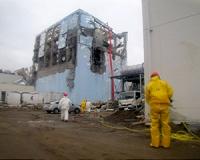 |
Sofia (AFP) March 30, 2011 Hundreds of people joined an anti-nuclear protest in Sofia on Wednesday, calling for the government to drop plans for a new Russia-backed nuclear plant after the radiation disaster in Japan. About 300 protestors -- some wearing gas masks and radiation suits -- gathered outside the government headquarters to shout "No to Belene!" against the planned 2,000 megawatt facility on the Danube in northern Bulgaria. Many people at the rally had yellow radiation signs stamped on their jackets and carried slogans reading "Stop the Nuclear Bomb in Belene." In a declaration distributed to journalists, the organisers warned that "the Fukushima disaster showed that the nuclear industry had not learned the lessons of (the world's worst nuclear accident in) Chernobyl." Safety concerns by Brussels forced Bulgaria to shut four reactors at its sole nuclear power plant at Kozloduy ahead of the country's European Union accession in 2007. Left with only two 1,000-megawatt blocs in operation at Kozloduy, Sofia re-launched long-stalled plans to build two new 1,000-megawatt reactors at Belene. In 2008, Bulgaria contracted Russia's company Atomstroyexport to build the plant. But work on Belene has been severely disrupted for over three years now amid financial haggling with Russia and the withdrawal of German utility RWE as a strategic investor in the project. Bulgaria's current right-wing government had earlier hinted it might drop the deal altogether. But in comments following the Japan disaster, Energy Minister Traicho Traikov said Sofia was continuing talks with Russia on the deal, where nuclear safety has always taken centre stage.
Share This Article With Planet Earth
Related Links Nuclear Power News - Nuclear Science, Nuclear Technology Powering The World in the 21st Century at Energy-Daily.com
 Fukushima: Sea contamination likely to be local - scientists
Fukushima: Sea contamination likely to be local - scientistsParis (AFP) March 29, 2011 Radioactive contamination of the sea from Fukushima is likely to be only a local problem, but could lead to an exclusion zone if there is a major release of long-term pollutants, scientists say. So far, the biggest contaminant identified by Japanese officials has been radioactive iodine 131. Samples of water taken close to the plant have been as high as 1,850 times the legal limit of iod ... read more |
|
| The content herein, unless otherwise known to be public domain, are Copyright 1995-2010 - SpaceDaily. AFP and UPI Wire Stories are copyright Agence France-Presse and United Press International. ESA Portal Reports are copyright European Space Agency. All NASA sourced material is public domain. Additional copyrights may apply in whole or part to other bona fide parties. Advertising does not imply endorsement,agreement or approval of any opinions, statements or information provided by SpaceDaily on any Web page published or hosted by SpaceDaily. Privacy Statement |